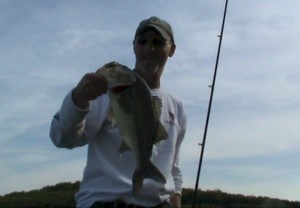 The spring of 2011 in Western Pennsylvania can be summed up in weather terms of “cold and very wet”. There is not doubt that the unusual weather has set all the lakes several weeks behind schedule as far as transitions. With water still hovering in the mid to high 60’s in early may, the Largemouth Bass are now approaching one of their “transitional periods”. This transition is the pre-spawn. After the ice out, when the water is still cold, the smaller males will invade the shallows looking to make the spawning beds for the coming spawn. The smaller males will congragate around wood cover, rock, and anything that holds the heat while they await the warmer temps when their bigger females will join them. Once the water temp reaches the upper 60’s, the females will transition from being suspended on the drop offs and deeper weedlines up onto the spawning ares of lakes. As all transitions, this can be the best time to catch a true trophy Largemouth Bass. The biggest females will move up to the spawning areas first and well ahead of the time that most anglers think. Not all areas of a lake will be golden to find this transition though. Time on the water and knowledge of the area will help eliminate many areas where the bass will not be. When looking for a pre-spawn transition area, look for the flats that are near a deeper drop-off. Points and pockets make great areas to try. Look for the harder bottom areas with sparse weeds, stumps or laydowns. Ideally you will be looking for all the cover mentioned but the bottom must be a harder silt and sand with pea gravel or small rocks in water anywhere from 6″ to about 4′ depending on the lake and water clarity. Many anglers focus on the shorelines looking for these areas, but the true transitional spot for me will be off shore a bit where all of the factors exist while being hidden a bit from the anglers looking for an easy find. Although in shallow water, as always, your electronics can help identify the bottom hardness. Another “old fashion” way to determine bottom hardness is to simply stick a pole in the water. If it comes up with mostly mud, then move on. On recent trips, i’ve done well with smaller bass using shad baits such as the Jackall Soul Shad. Now that the big ones are starting to get active, I prefer to cover water with shallow running crankbaits (Backstabber Lures 0′-4′ Stabber) and homemade Chatterbaits. The areas I have been hitting are a bit stained in water color so the Chatterbait, with it’s erratic actions and incredible vibration, has been producing well. In this transitional phase, time on the water and knowing the factors of where to find the bass in transition will help increase your catch in both numbers and weight.
The spring of 2011 in Western Pennsylvania can be summed up in weather terms of “cold and very wet”. There is not doubt that the unusual weather has set all the lakes several weeks behind schedule as far as transitions. With water still hovering in the mid to high 60’s in early may, the Largemouth Bass are now approaching one of their “transitional periods”. This transition is the pre-spawn. After the ice out, when the water is still cold, the smaller males will invade the shallows looking to make the spawning beds for the coming spawn. The smaller males will congragate around wood cover, rock, and anything that holds the heat while they await the warmer temps when their bigger females will join them. Once the water temp reaches the upper 60’s, the females will transition from being suspended on the drop offs and deeper weedlines up onto the spawning ares of lakes. As all transitions, this can be the best time to catch a true trophy Largemouth Bass. The biggest females will move up to the spawning areas first and well ahead of the time that most anglers think. Not all areas of a lake will be golden to find this transition though. Time on the water and knowledge of the area will help eliminate many areas where the bass will not be. When looking for a pre-spawn transition area, look for the flats that are near a deeper drop-off. Points and pockets make great areas to try. Look for the harder bottom areas with sparse weeds, stumps or laydowns. Ideally you will be looking for all the cover mentioned but the bottom must be a harder silt and sand with pea gravel or small rocks in water anywhere from 6″ to about 4′ depending on the lake and water clarity. Many anglers focus on the shorelines looking for these areas, but the true transitional spot for me will be off shore a bit where all of the factors exist while being hidden a bit from the anglers looking for an easy find. Although in shallow water, as always, your electronics can help identify the bottom hardness. Another “old fashion” way to determine bottom hardness is to simply stick a pole in the water. If it comes up with mostly mud, then move on. On recent trips, i’ve done well with smaller bass using shad baits such as the Jackall Soul Shad. Now that the big ones are starting to get active, I prefer to cover water with shallow running crankbaits (Backstabber Lures 0′-4′ Stabber) and homemade Chatterbaits. The areas I have been hitting are a bit stained in water color so the Chatterbait, with it’s erratic actions and incredible vibration, has been producing well. In this transitional phase, time on the water and knowing the factors of where to find the bass in transition will help increase your catch in both numbers and weight.